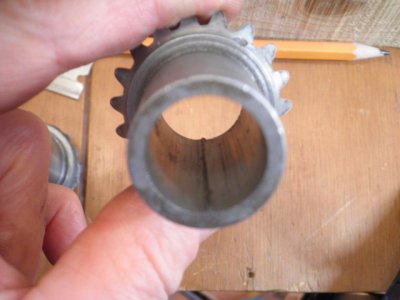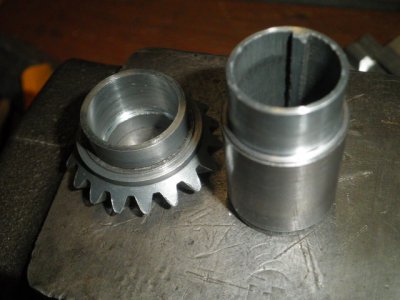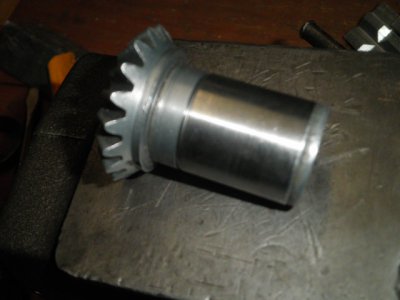-
Welcome back Guest! Did you know you can mentor other members here at H-M? If not, please check out our Relaunch of Hobby Machinist Mentoring Program!
You are using an out of date browser. It may not display this or other websites correctly.
You should upgrade or use an alternative browser.
You should upgrade or use an alternative browser.
12" Atlas Reverse Tumbler Gear Stud
- Thread starter paul s
- Start date
I'm still on the job here, have a new issue: The two miter gears in the apron were stripped badly. I found both on ebay, but the one I bought that rides on the leadscrew has a thin ridge, where the cast in key should be. I've searched and read here regarding sheared keys, but the strange part is that there's no evidence where the base of the key would have been, that it had ever been there. Unless action from the leadscrew wore the ID smooth, so as to remove any jagged traces. It almost makes me think that it was intentional, like a shear mechanism to protect the gears. The other notable difference, is that the original gear had a steel wear liner, apparently cast into it.
I have a broach, I suppose I could broach, insert a new key and secure it. Also, wondering about the possibility of cutting/turning the original gear off, cutting the new gear section off its "shaft" and mating the good gear section with the original shaft.
I have a broach, I suppose I could broach, insert a new key and secure it. Also, wondering about the possibility of cutting/turning the original gear off, cutting the new gear section off its "shaft" and mating the good gear section with the original shaft.

- Joined
- Dec 25, 2011
- Messages
- 10,552
I don't know what it would look like "in person" but in your photo appears a dark line approximately where the right side of the cast-in key would have been. My guess would be that it never got lubricated. I would attempt to return the gear as worn out or defective. It would be better if you had a new gear to photograph to prove what it should look like.
The seller refunded my money and told me to keep the part. So, I've got nothing to lose - should I broach a key way? It'll extend through one of the gear teeth, not sure if it'll make much difference.
Got the motor back together today with the new bearings. There are two flat compression type springs on one end - I'm pretty sure they were both oriented in the same direction (they're not symmetric). Can anyone here confirm?
Got the motor back together today with the new bearings. There are two flat compression type springs on one end - I'm pretty sure they were both oriented in the same direction (they're not symmetric). Can anyone here confirm?
Still on the job, here: The original apron miter gear had sheared teeth but a good key; the ebay one had good teeth, but a sheared key. I combined the two, sleeving them together and securing with Permatex sleeve retainer. Since I didn't want to thin out the area under the gear too much, the part ended up a bit longer than the original, 1.962" vs. 1.745". There's enough clearance in the apron, that the gear could be almost 1/2 inch longer than it is. As a bonus, I retained the full length of the key.
Meanwhile, the 2 step motor pulley has got quite a wobble - I thought it was the shaft reducer on the motor. I turned down a piece of stock in my other lathe to a tight slip fit for the pulley bore and spun the pulley on the lathe - same wobble. I don't know if it would work to true it up or not, I suppose I would have to use an expanding arbor, but I would end up changing the profile of the v section. So, I've got a nice cast and machined Browning pulley that fits, runs fairly true, but it's single step, somewhere between the two original steps. I calculated a top speed at the spindle of roughly 1200 rpm, which should be enough, although I know original is closer to 2000. At the bottom, I suppose back gear will take care of things.


Meanwhile, the 2 step motor pulley has got quite a wobble - I thought it was the shaft reducer on the motor. I turned down a piece of stock in my other lathe to a tight slip fit for the pulley bore and spun the pulley on the lathe - same wobble. I don't know if it would work to true it up or not, I suppose I would have to use an expanding arbor, but I would end up changing the profile of the v section. So, I've got a nice cast and machined Browning pulley that fits, runs fairly true, but it's single step, somewhere between the two original steps. I calculated a top speed at the spindle of roughly 1200 rpm, which should be enough, although I know original is closer to 2000. At the bottom, I suppose back gear will take care of things.


